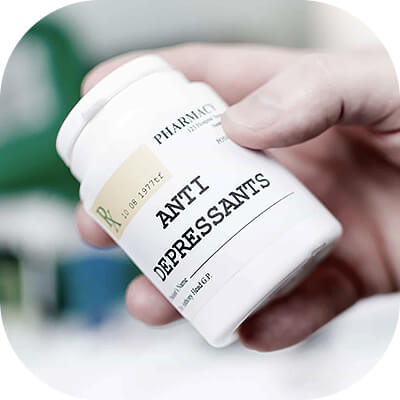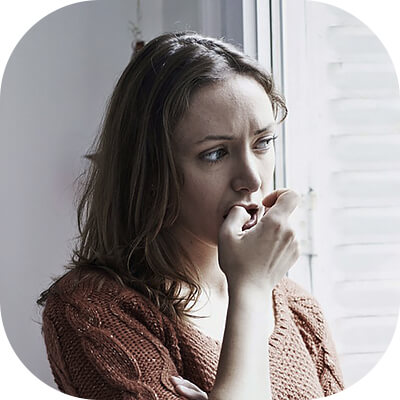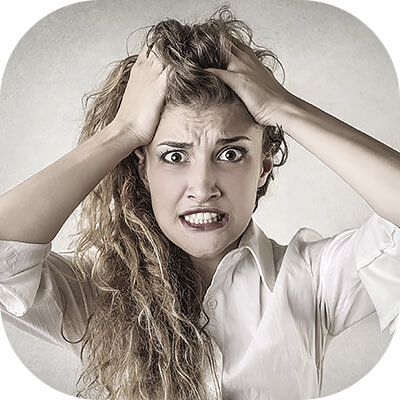Mental disorders accompanied by an abrupt change in a person's emotional state belong to the category of affective disorders. They can be characterized by abrupt changes in the dynamics and disturbances in the manifestation of standard human emotions. Treatment of an affective disorder at a specialized clinic can in most situations provide a favorable prognosis for improvement in well-being and self-perception.
Syndromes of affective disorder
Depending on the prevailing symptomatology, different affective disorder syndromes are distinguished:
- Related to impaired metabolism of brain tissue depression. Manifestations of depression are associated with the patient's state of extreme despondency and hopelessness. This syndrome is characterized by suicidal thoughts, often leading to attempts to end one's existence. Without the necessary therapy, the syndrome is capable of continuing for a long period.
- Dysthymia differs from depression in its milder form. The patient is depressed during the day, anxiety increases, and moods worsen.
- With bipolar disorder, the patient is in alternating phases of depressed mood and euphoria. Previously, such a disorder was referred to as "manic-depressive psychosis". In the depressive state, the patient's mood is depressed. Moving to the manic stage, the patient becomes alert, often overactive, and aggression, delirium and irritability appear. In the case of the maximal stage of manifestation of alternating states, bipolar disorder is called cyclomia.
- In the case of depressive disorders, the patient is tormented by increased anxiety, fear, inner restlessness. The patient constantly expects tragedy, impending disaster. In severe cases, movement disorders and panic attacks are possible.
- Cotard syndrome is accompanied by nihilistic-pochondriacal delirium accompanied by ideas of grandiosity. Occurs in involutionary melancholia and recurrent depression.
- Manic syndrome (mania) is accompanied by a joyful mood of increased level. The patient suffers from an increased desire for constant activity, and there is an increased level of optimism, cheerfulness, and inadequate joy. Attention is distracted, superficiality of judgment, verbosity, hypermnesia, thoughts are incomplete, fatigue is absent, attitude toward self is idealized. A mild manic state (hypomania) is present.
Affective disorders require immediate referral to a specialist. They are often the debut of various mental disorders. They can persist for the entire period of the ensuing mental illness.
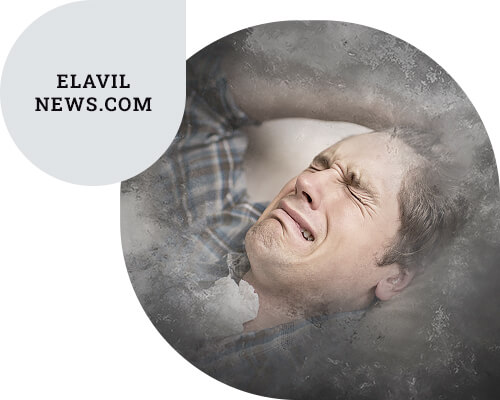
Treatment for affective illness
In medical practice, the treatment of affective disorders is developed individually for each patient. Consideration must be given to the symptoms present and the presence of additional illnesses. In developing a program, procedures are implemented designed to:
- To arrest the active stage of the illness, if it is present;
- Eliminate the cause of the pathology;
- Conduct psychotherapeutic work;
- Increase adaptive capacity through social work.
The composition of a comprehensive approach to conducting therapy for all types of syndromes includes:
- Application of medication treatment;
- Psychotherapy;
- Social rehabilitation.
Hospitalization is recommended for acute exacerbations and suicidal ideation. Each type of illness requires separate approaches in developing a course.
Affective mood disorder
Almost everyone has experienced mood swings, often with no particular reason. In some cases, such mood swings, caused by fatigue or based on pleasant occasions, cease to be only one manifestation of the norm. In this situation, they require a diagnosis and the development of a treatment program.
The cause of the appearance may be a genetic predisposition or external factors. For example, a strong shock caused by the death of a loved one. Joy also becomes an occasion.
To correct the condition, a personal conversation between a specialist and a doctor is required to establish the exact diagnosis. The elimination of triggering factors can remove the state of affect. Sedatives and antidepressants are used in therapy.
Affective mental disorder
In this situation, the patient's condition becomes pathological and interferes with his normal activities. Therapy is often prolonged. Requires the use of pharmacological drugs.
As in other situations with this disease, first of all, the patient is removed from the stage of an acute attack. Identification of the causes that can be a provoking factor is carried out in consultation with a psychologist. The pathology is characterized by alternating periods of exacerbations and remissions. The control of a specialist at any stage is required, and attendance at preventive examinations.
Affective Spectrum Disorders
In most cases, medics try to manage the manifestations of affective spectrum disorders under restrictive conditions. Hospitalization is required for acute manifestations. At the initial stage of confronting the pathology, the drugs used to control combinations of neuroleptics and antipsychotics. The use of anticonvulsants of the Valproate group may be required.
In the presence of psychosomatic symptoms, second-generation neuroleptics are used. Such as Cardolex, Clopixol acufaz. The second generation of these drugs has fewer side effects. Drug resistance after 4 weeks of use becomes a recommendation for prescription of anticonvulsants. Lithium salt is prescribed.
Depressive affective disorder
Literally translated in Latin, depression is called "depression." It is not a condition that can be completely cured today, but it can be corrected and managed. Therapy helps improve the psychological and physiological condition of the patient. Using a combination of psychological and biological treatments. In addition to medical drugs, folk recipes have a high degree of efficacy. First of all, herbal sedative teas, yoga. Patients are shown courses of psychotherapy and soothing baths. Following a healthy diet and avoiding alcohol plays a positive role.
Organic affective disorder
Antidepressants are used in treatment. They improve the emotional state, reduce anxiety. Removal of the factors that provoke the condition is required.
Organic affective states are caused by physiological factors. Such as prolonged illness, withdrawal of certain medications, consequences of craniocerebral trauma, postoperative state.
The prescription of medications is based on the medications that the patient is forced to take in accordance with the underlying diagnosis. In most situations, medics prefer to emphasize the use of psychotherapy, sedative infusions and teas, and physical therapy procedures.
Manic Affective Disorder
The problem for a successful course is often the patient's aversion to having a diagnosis. A complete evaluation is conducted to rule out concomitant dementia or schizophrenia. Therapy includes sessions with a psychotherapist and prescription of medications. Anticonvulsive therapy is recommended.
In severe cases, involuntary hospitalization is required. In such a situation, doctors need the support of the patient's relatives.
Emotionally affective disorders
With such a lesion, there is a maximum change in the perception of the world around you. The reaction to the provoking factor becomes excessive. There is a loss of understanding of the surrounding situation, while understanding of the person's actions in the unfolding situation is reduced.
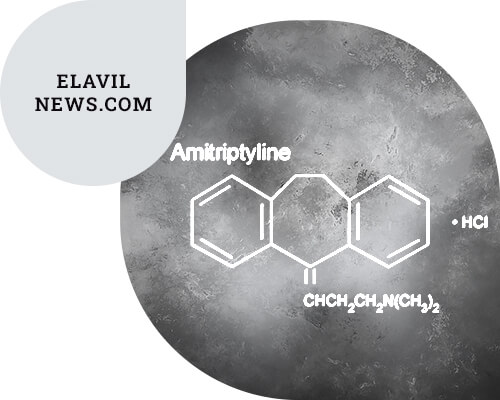
The provocateur becomes prolonged exposure to psychotraumatic cases, reaching the point of a pathological reaction of the brain. The patient loses control and does not evaluate adequately what is going on. Provocateurs include the death of a loved one, a sharp decrease in social status and material level, and the occurrence of hormonal imbalance. Tricyclic antidepressants, neuroleptics, normotimics, tranquilizers, mood normalizers are used in therapy.
In the absence of positive dynamics, anticonvulsant therapy is prescribed. Psychotherapy sessions are conducted both with the patient and with his environment.
Bipolar affective disorder treatment
For therapy, courses of normotics are used. Such as Carbamazepine, lithium therapy, and valproic acid. Treatment is divided into a stage of the patient's recovery from the acute stage and further preventive therapy, which may be carried out for life. At this stage, the use of lithium solution is recommended. When its intake is discontinued, about half of patients experience a relapse within a few weeks. Complete withdrawal for up to 5 years results in relapse in 94% of patients.
This remedy shows a positive effect in 60% of patients with short cycles and up to 20% of patients with long cycles. Additional medications are prescribed. If lithium is highly effective, its positive effect comes about 5 days after starting to take it. During this period, other medications are used. Constant monitoring of the effect of the drug on the body is required. Reception is discontinued when dysarthria, widespread tremor and ataxia appear. Most often negative symptoms are observed in the elderly and patients with a weakened state of health.
Bipolar affective disorder symptoms
This disorder leads to a complete loss of orientation in the world around a person. Suicidal thoughts arise, careers cease, and interpersonal relationships collapse. The disorder provokes life-threatening antisocial behavior.
The main symptom becomes a sharp change of moods. Depression changes into euphoria. The change of cycles is of a chaotic nature. The duration of the phases is impossible to determine. Sometimes the duration of the phases is years. In the interval between attacks, there are no outward manifestations of the diagnosis, and the patient feels completely healthy.
During the period of depression, irritability, unmotivated anger, hopelessness and embarrassment are noted. In the euphoric phase, the patient may be prone to excessive spending or uncontrolled sexual relations.
In different phases, the physiological state changes. In the manic phase, the patient feels a surge of energy, is overly active, is mobile, laughs a lot, speech becomes loud, and movements are impulsive.
The depressive stage is characterized by a sharp decrease in strength. It becomes difficult for the person not only to move, but also just to think. The duration of the depressive state is about two weeks. The recurrence of the change of states occurs in most cases at least once every two years in the most ideal course of the disease.
The onset of the condition often occurs in the 20s and 30s. Relatives of the condition may mistake it for a mental disorder. On average, the disease affects two people in a hundred.
Bipolar affective disorder diagnosis
Diagnosis is carried out by a physician psychiatrist or psychotherapist. In determining the diagnosis, the following is carried out:
- An interview with the patient and his or her environment;
- A clinical psychologist conducts a pathopsychological study;
- Laboratory tests are performed, including blood tests, neurotest, EEG, and a neurophysiological test system is prescribed;
- Consultations with a neurologist, cardiologist, and endocrinologist are necessary.
In complex cases, it is recommended to undergo a medical board, gathering several specialists. At the moment there are no signs of the disease with the help of CT and MRI scans.
Symptoms of affective disorders
Accurate diagnosis of affective disorders is complicated by a wide list of causes that can provoke a deterioration in health. Self-diagnosis of the disease is not amenable to diagnosis. Only a psychiatrist or psychotherapist provides an accurate assessment. Specialists will also determine the exact diagnosis.
Nevertheless, in medical practice, there is a list of symptomatology to suggest the presence of affective disorder. Signs characteristic of all types:
- Mood swings occur over an extended period with high frequency;
- A decrease in activity level and cognitive tempo;
- The person's perception of themselves and situations changes drastically;
- A noticeable decrease in the level of activity, depression, and loss of interest in what is going on;
- Appetite changes; it usually goes down to complete starvation, but can also increase sharply;
- The patient suffers from a lack of sleep;
- Mental anguish can lead to pain in any part of the body without cause;
- Sexual activity decreases, up to complete asexuality.
Only a specialist will prescribe the correct treatment after consultation.
Types of affective disorders
All types of affective disorders are described in the international classifier under the ICD 10 code F30-39 episodes. According to the classifier, the types are defined as follows:
- F30 manic episode, is established only in case of a single manifestation of the disease, in case of recurrence, medics establish the fact of bipolar disorder;
- F31 bipolar mental disorder, characterized by recurrence;
- F32 depressive episode, accompanied by a drop in activity, increased fatigue, decreased appetite, insomnia, decreased self-confidence and self-esteem. Can be mild, pronounced and severe.
- F33 recurrent depressive disorder is distinguished by the presence of recurrent episodes of depression. Mood swings, with a change from mania to euphoria, are absent. The onset of the disorder is possible at any age. Including childhood. With a manic episode, especially if recurrent, is classified as bipolar disorder.
- F34 Persistent mood disorders lasting for years, often throughout life, but not severe enough to be classified as mild depressive or hypomanic episode.
- F38 Other mood disorders that do not fall into the types listed.
- F39 BDU (affective psychosis).
Diagnosis is made in a clinical setting. Only a qualified psychotherapist or psychologist makes an accurate diagnosis.
Diagnosis of affective disorders
In cases of sudden mood swings, the presence of affective disorders can be assumed. Common to all types of these diagnoses is a possible association with seasonality. Exacerbations are often associated with climatic changes in environmental conditions. The activation of the diagnosis is directly related in most patients to stressful situations.
On their own, the patient or his relatives can only assume the possible presence of such a diagnosis. A visit to a physician is required for an accurate determination. The determination is made after a personal consultation with a psychologist or psychotherapist. Affective disorders are not completely cured. Follow-up with a physician will be lifelong in order to rule out recurrence.
When a diagnosis is made, laboratory tests are performed: EEG, blood tests. They are primarily designed to rule out the presence of additional diagnoses. MRI or CT scans are not used for investigations.
Affective personality disorder
Mood regulation disorder is seen in many people throughout their lifespan. Such fluctuations suffer or are simply distinguished by impressionable citizens who are prone to heightened perception of what is happening. But not all cases of dysregulation are of a clinical nature.
The pathology is characterized by a noticeable and cyclic alternation of depression and euphoria. In the absence of treatment, such fluctuations can occur even without additional provoking factors.

Patients suffering from any type of affective personality disorder are rarely able to control the changes in their condition. Controlling the condition requires follow-up with a specialist in order to promptly incorporate medication. Affective personality disorder without treatment leads to the destruction of the patient's personality. It reduces the quality of life and disrupts personal and social life. Periods of low and high energy disrupt the body, often leading to suicidal moods.
Seasonal Affective Disorder
It occurs in people who are prone to seasonal depression. Periods occur around the same time of year. It is classified as F32.1 within the general disorder.
Two types are distinguished. The most common is the winter one, with a start in the fall months. It is usually in September and October. The active period lasts until early spring. Much less common is the summer type, which lasts from early spring to late fall.
The first attack in most cases occurs between the ages of 15 and 55. The average age of patients first presenting with complaints of seasonal affective disorder is 23 years. The risk of onset decreases with age. Women suffer from seasonal affective disorder more often than men.
Approximately one-third of patients tolerate seasonal depression fairly easily. The illness manifests itself in the form of some loss of strength and worsening of mood. The majority of patients find seasonal depression difficult to tolerate. They worsen the quality of life, destroy personal connections, and ruin careers.
At risk are:
- People whose family has previously been diagnosed with affective disorders and GAP;
- People living in northern latitudes, where most of the daylight hours are very short.
Patients suffer from decreased libido, increased somnolence, hypochondria, and persistent fatigue despite long periods of rest. Autonomic disturbances are observed.
This type of affective disorder resolves completely on its own after the season is over in most situations.
In summary, it is worth noting that with proper treatment, affective disorders are successfully corrected, progressing into a state of persistent remission. To exclude relapses, patients require constant monitoring by a doctor, implementation of recommendations and taking medications if necessary.
Affective syndrome refers to a fairly common cause of impairment in the human body. It is characterized by the onset of changes in the brain at a dienfical level. This disturbs the regulation of the body's biotones, causing a decrease in their regulation, mood and tempo of mental processes. Treatment of affective syndrome is conducted under the supervision of specialists.
Manifestation of affective syndrome
Pathology manifests itself in the form of negative emotional disturbances, depressions and delusions. In some cases are accompanied by physiological disorders:
- Difficulty breathing with a feeling of incomplete breaths;
- Heaviness in the chest;
- Sluggishness of movements and reactions;
- Slowness of thought processes;
- Loss of interest in things that were previously important to the patient.
Depressive states of various types manifested in the pathology:
- Manic-depressive psychoses;
- Depressions of psychogenic character;
- Endogenous depressive conditions;
- Depressions of a somatic nature.
Characterized by an abrupt change, often occurring within a single day. The period of attacks can last for several months or even years. Sleep disturbances are observed, appetite changes, and weight loss may be noted.
Treatment of affective syndrome
When eliminating the pathology, complex therapy with the use of medications and psychological training is used. Patients with psychiatric disorders that manifest themselves in panic attacks are prescribed classes in mastering self-regulation techniques. Work is done to increase self-esteem.
Social adaptation is used for successful therapy. In such a situation, participation of members of the patient's family and immediate environment is recommended in psychological training groups.
Affective syndrome in children
Affective disorders of the depressive and manic type occur not only in adult patients, but also in children. Medicine is unable to pinpoint the exact cause of these disorders in minors. The provoking factors include a genetic predisposition and constant psychotraumatic situations. Manifestations are observed in the earliest stages of child development. The period from 12 to 20 months is especially dangerous for the start of the diagnosis.
Unstable psychoemotional state of the baby with frequent mood swings allows you to suspect the presence of the diagnosis. Children suffer from hallucinations. Seizures can occur at significant time intervals. Immediate medical attention is required:
- In cases of suicidal threats;
- Attempts to physically harm oneself;
- Identification of cases of hallucinations.
Treatment is conducted jointly by a child psychologist and psychiatrist, a pediatrician. In the absence of a clear understanding of the causes of the onset of the disease, there are no preventive measures. With early detection of the disease, the prognosis is favorable. A combination of medication therapy and psychological practices can reverse the development of the pathology in the child.
Variety of affective syndrome
Diagnosis and successful initiation of treatment for affective syndrome is associated with a clear definition of the type of pathology.
Affective respiratory syndrome
A serious psychoemotional irritant becomes the cause of the start of the pathology. It is accompanied by attacks of suffocation, panic attacks caused by the inability to continue normal breathing. It occurs quite rarely in adult patients, at the expense of gaining the skill to control one's emotional state in cases of sharp moral and physical turmoil.
Affective delirium syndrome
A polymorphic psychotic disorder often caused by schizophrenia. Manifestations in situations of diagnosis of delirium and depression in patients suffering from various mental illnesses.
Affective Paranoid Syndrome
Refers to exacerbations of recurrent and schizophrenia, acute paraphrenia, and other psychiatric diagnoses. It is manifested by symptoms of a blackout of consciousness in the form of a coma, a state of deafness, hypochondria, a constant feeling of guilt. Accompanied by motor disturbances. Such as agitation, changes in the rate of associations from complete slowing down to acceleration at the level of a "whirlwind of ideas".
Affective endogenous syndrome
Occurs in endogenous diagnoses, somatogenic mental pathologies. It is accompanied by frequent changes in mood phases. The maximum duration of depressive periods lasts up to 6 months. During remission, the pathology may be virtually invisible.
Affective respiratory syndrome in children
Is a frequent response of the body to sharp provoking situations in the form of delayed or even stopped breathing. This manifestation also occurs during prolonged periods of crying. Can be accompanied by convulsions, loss of consciousness. In rare situations, it develops into epilepsy.
Syndrome of affective instability
State of emotional instability, which is on the edge of normal. Referral to a specialist is recommended:
- In the case of frequent breakdowns, so-called "psychotic";
- Affective outbursts;
- Mood swings, often occurring at an unconscious level;
- Behavioral control at a low level.
Manifestations in most situations are associated with stressful states, weather changes. Unstable psychopathy borders on schizophrenia.
Affective and depressive syndrome
Constantly low mood, energy and performance are reduced, often patients refuse to control their appearance. A lack of grooming appears. Mood does not improve in pleasant company. Suicidal thoughts often arise.
Syndromes of affective pathology
Extremely varied. A common symptom is impairment of the emotional state from a state of excessive joy to deep depression. When frequent mood swings are detected, referral to a specialist to determine the exact diagnosis is recommended.
Affective Hallucinatory Syndrome
Characterized by a combination of delusional and hallucinogenic disorders. Patients may experience visual and auditory hallucinations, and emotional status is reduced or conversely there is increased agitation.
Bipolar affective syndrome
Refers to endogenous mental health disorders. It is characterized by an abrupt change of polar states from deep depression to a manic state. Requires mandatory medication treatment. During the remission period, the patient practically does not notice sharp mood swings.
By: Dr. Anna Fishzon


